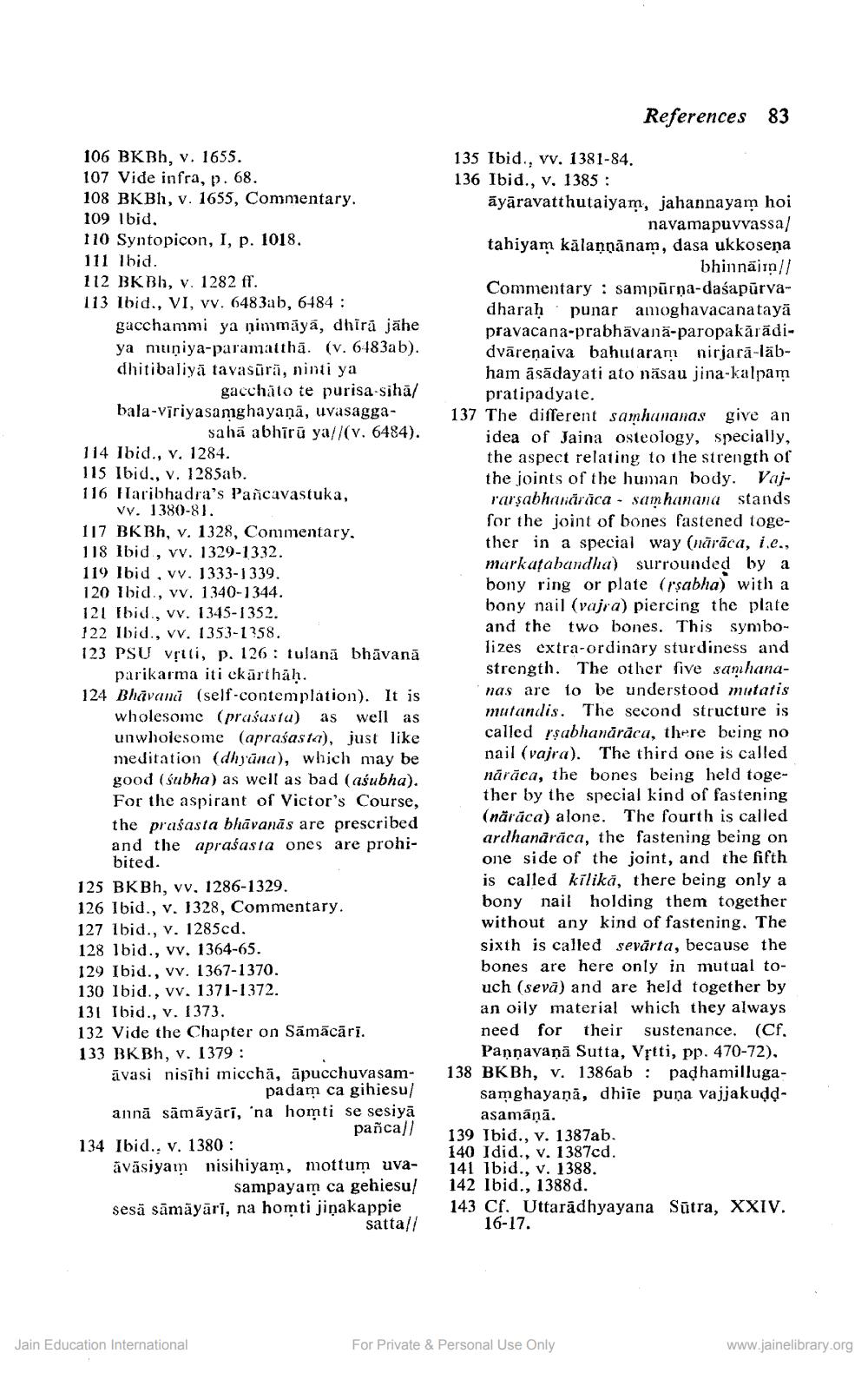________________
References 83
106 BKBh, v. 1655. 107 Vide infra, p. 68. 108 BKBH, v. 1655, Commentary. 109 lbid. 110 Syntopicon, I, p. 1018. 111 lbid. 112 BKBh, v. 1282 ff. 113 Ibid., VI, vv. 6483ab, 6484 :
gacchammi ya nimmāyā, dhira jāhe ya muniya-paramatthā. (v. 6183ab). dhitibaliyā tavasarā, ninti ya
gacchăto te purisa-sihā/ bala-Viriyasamghayaņā, uvasagga-
sahá abhiru ya//(v. 6484). 114 Ibid., v. 1284. 115 Ibid., v. 1285ab. 116 Haribhadra's Pancavastuka,
Vy. 1380-81. 117 BKBh, v. 1328, Commentary, 118 Ibid, vv. 1329-1332. 119 lbid. vv. 1333-1339. 120 lbid., vv. 1.340-1344. 121 Ibid., vv. 1345-1352. 122 Ibid., vv. 1353-1358. 123 PSU vrtti, p. 126: tulanā bhāvanā
parikarma iti ekārthāh. 124 Bhavanů (self-contemplation). It is
wholesome (prasasiu) as well as unwholesome (aprašasta), just like meditation (dhrūna), which may be good (śubha) as well as bad (aśubha). For the aspirant of Victor's Course, the praśasta bhāvanās are prescribed and the aprašasta ones are prohi
bited. 125 BKBh, vv, 1286-1329. 126 Ibid., v. 1328, Commentary. 127 Ibid., v. 1285cd. 128 lbid., vv. 1364-65. 129 Ibid., vy. 1367-1370. 130 lbid., vv. 1371-1372. 131 Ibid., v. 1373. 132 Vide the Chapter on Sämācārī. 133 BKBh, v. 1379 : āvasi nisihi micchā, āpucchuvasam-
padam ca gihiesu/ annā sāmāyārī, 'na homti se sesiyā
panca// 134 Ibid., v. 1380 : āvāsiyam nisihiyam, mottum uva
sampayam ca gehiesu! sesā sāmāyāri, na homti jinakappie
satta//
135 Ibid., vv. 1381-84. 136 Ibid., v. 1385 : āyāravatthutaiyam, jahannayam hoi
navamapuvvassa/ tabiyam kälanņānam, dasa ukkosena
bhinnäjm// Commentary : sampūrņa-daśapūrvadharah punar amoghavacanataya pravacana-prabhāvanā-paropakārādidvārenaiva bahutaran nirjarā-labham āsādayati ato näsau jina-kalpam
pratipadyate. 137 The different samhananas give an
idea of Jaina osteology, specially, the aspect relating to the strength of the joints of the human body. Vajrarşabhandrica - samhanana stands for the joint of bones fastened together in a special way (nārāca, i.e., markațabandha) surrounded by a bony ring or plate (rşabha) with a bony nail (vajra) piercing the plate and the two bones. This symbolizes extra-ordinary sturdiness and strength. The other five samhananas are to be understood mutatis mutandis. The second structure is called rşabhanārāca, there being no nail (vajra). The third one is called nārāca, the bones being held together by the special kind of fastening (närāca) alone. The fourth is called ardhanårāca, the fastening being on one side of the joint, and the fifth is called kilikā, there being only a bony nail holding them together without any kind of fastening. The sixth is called sevărta, because the bones are here only in mutual touch (sevā) and are held together by an oily material which they always need for their sustenance. (Cf.
Pannavaņā Sutta, Vịtti, pp. 470-72), 138 BK Bh, v. 1386ab: padhamilluga
samghayaņā, dhiie puņa vajjakudd
asamāņā. 139 Ibid., v. 1387ab. 140 Idid., v. 1387cd. 141 Ibid., v. 1388. 142 Ibid., 1388d. 143 Cf. Uttarādhyayana Sūtra, XXIV.
16-17.
Jain Education International
For Private & Personal Use Only
www.jainelibrary.org




